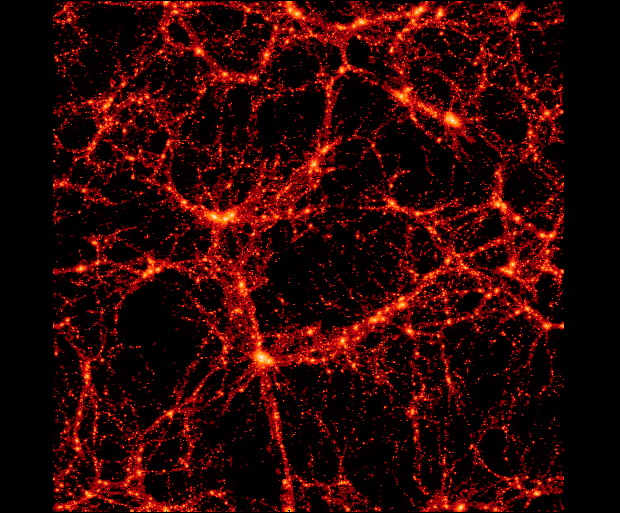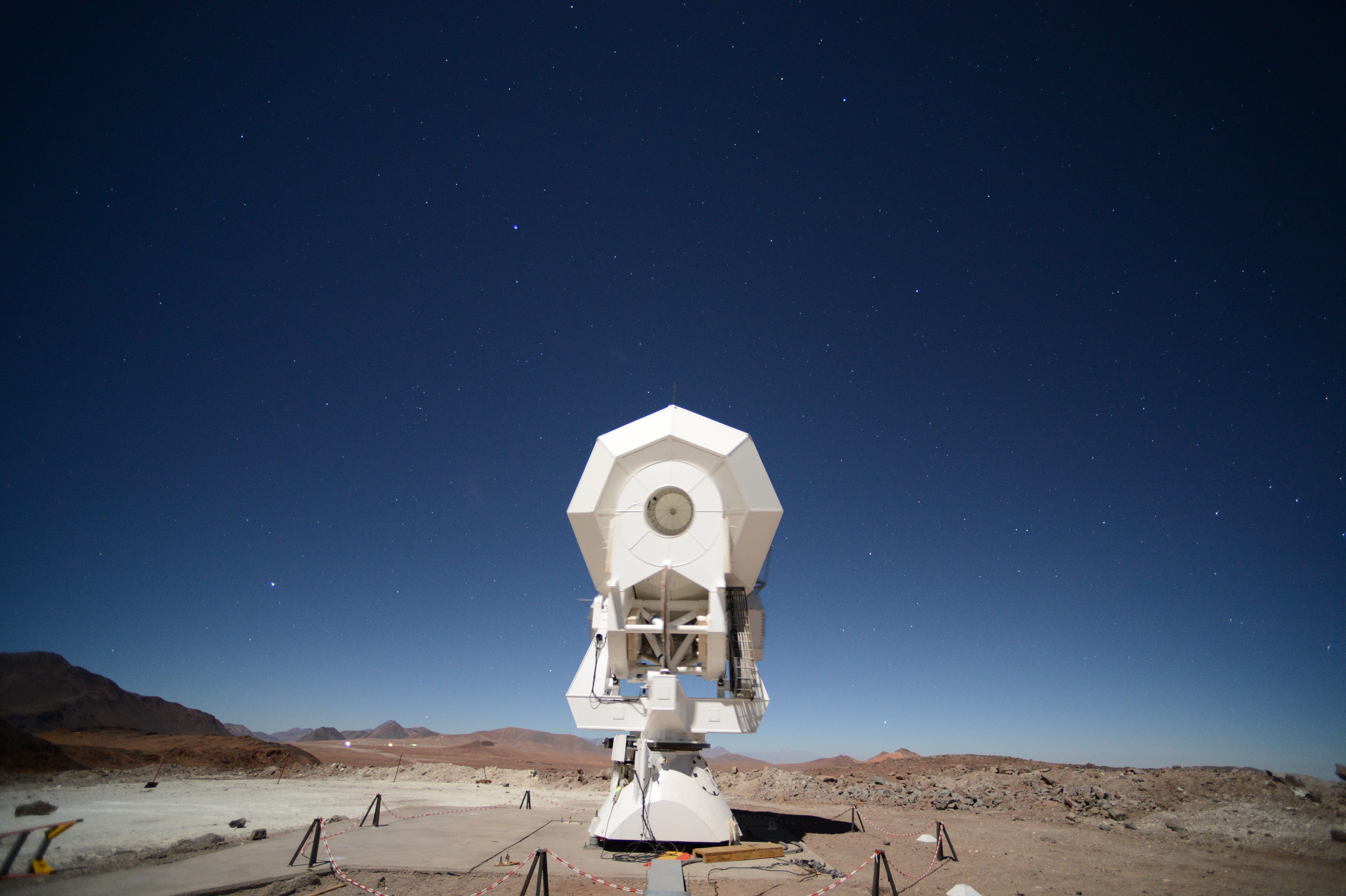Big Bang's Echo May Reveal Skeleton of the Universe

Scientists may soon get a look at the universe's skeleton by taking a close look at light left over from the Big Bang, which can be used to reveal the presence of matter like stars, galaxies, black holes and even larger structures in the otherwise empty universe. It's a lot like an X-ray revealing bones in a body, but on a cosmic scale.
X-ray machines work by shining light over an entire area and detecting how different materials react. The light passes through tissue, but is stopped by bone.
In a similar way, scientists with the international POLARBEAR collaboration want to use a diffuse light that fills every corner of the cosmos to indicate where there is matter and where there is none. POLARBEAR studies the cosmic microwave background (CMB) — the surviving light from the infant universe that is normally seen a kind of baby picture of the cosmos. Scientists estimate the universe is about 13.8 billion years old. [The History & Structure of the Universe in Pictures]
"We're using the light that we've usually used to measure the seeds of the structure of the universe, to measure the whole tree," said Adrian Lee, a professor of physics at the University of California Berkeley, and a lead scientist with POLARBEAR. "But the mechanism [we use] is pretty different. Instead of looking at a baby picture, we're looking at the distortion of the baby picture."
Bending cosmic light
Just as the bones in a skeleton are not randomly scattered in the body, the mass in the universe is not randomly scattered through space. Forces such as gravity drive the organization of matter, so stars get grouped into galaxies; galaxies herd together into galaxy clusters; and on an even larger scale, scientists think matter in the universe is arranged into a structure resembling a web, with vast regions of emptiness between strings of galaxy groups.
The gravity of massive objects can bend light. The light moves around the object like water going around a rock in a stream. This bending causes a change in the CMB, and POLARBEAR scientists say they have now detected that change.
The bending of light by a massive object is called gravitational lensing, and it changes a property of the light called polarization. When sunlight reflects off the surface of water, it often becomes polarized. Polarizing sunglasses can block this polarized light, but they do not block the sunlight coming from above — ideal for water sport fans.
Get the Space.com Newsletter
Breaking space news, the latest updates on rocket launches, skywatching events and more!
CMB light that has not been gravitationally lensed — that has never bumped into any type of matter — has a so-called E-mode polarization. New results from the collaboration show that the researchers can detect something called B-mode polarization, which means the CMB has encountered a massive object on the way to Earth.
POLARBEAR has only just demonstrated that it can detect this polarization, but eventually, it could create a sketch of the large-scale skeleton inside the universal body.

Dark energy and exotic dragons
Seeing the universe's skeleton — the location and structure of all matter — could tell scientists if they've got the right idea about how matter in the universe is arranged, and if there are yet-unknown forces acting on it in peculiar ways.
"There's some possibility [the structure] won't look the way theorists predict," Lee said. "[POLARBEAR] could confirm that the universe is acting the way we think it is; that there are no exotic dragons out there changing the signal."
The most dominant force in our universe is dark energy, but scientists know very little about it -- only that it's causing our universe to expand like a balloon. They don't know when dark energy started this expansion, but Lee said it would have had an effect on how structures formed.
"Gravity wants to pull structures together but dark energy wants to pull them apart," Lee said. "If dark energy was acting more strongly early on in the universe that would suppress structure formation, because [the dark energy] would be yanking masses away from each other." Lee said future data from POLARBEAR could help identify when dark energy started pushing the universe apart.
Flexing BICEP2
Earlier this year, members of the BICEP2 collaboration announced that they had detected B-mode polarization in the CMB. But that polarization signal comes from a different source than the one detected by POLARBEAR. The BICEP2 polarization may come from gravitational waves, or ripples in space-time, in the early universe.
Detection of this type of B-mode polarization would indirectly demonstrate the existence of gravitational waves, and their presence in our early universe. But following BICEP2's announcement, observations by the Planck satellite have raised questions about whether the results were contaminated by space dust.
It's possible, said Lee, that POLARBEAR could eventually measure polarization created by gravitational waves from the inflating universe. Those polarization patterns are larger on the sky than the lensing polarization that POLARBEAR has measured, but as BICEP2 has shown, they are in some ways more challenging to observe.
POLARBEAR's observations alone can provide only a two-dimensional map of the matter in the universe. But with the help of other telescopes, Lee said it would be possible to create a three-dimensional map, and to even determine when the structure appeared in the universe.
"If we use other data, if we cross correlate, we could look at the structure of matter over the whole history of the universe," Lee said. "That's the strength of all the data sets together."
Follow Calla Cofield @callacofield. Follow us @Spacedotcom, Facebook and Google+. Original article on Space.com.
Join our Space Forums to keep talking space on the latest missions, night sky and more! And if you have a news tip, correction or comment, let us know at: community@space.com.

Calla Cofield joined Space.com's crew in October 2014. She enjoys writing about black holes, exploding stars, ripples in space-time, science in comic books, and all the mysteries of the cosmos. Prior to joining Space.com Calla worked as a freelance writer, with her work appearing in APS News, Symmetry magazine, Scientific American, Nature News, Physics World, and others. From 2010 to 2014 she was a producer for The Physics Central Podcast. Previously, Calla worked at the American Museum of Natural History in New York City (hands down the best office building ever) and SLAC National Accelerator Laboratory in California. Calla studied physics at the University of Massachusetts, Amherst and is originally from Sandy, Utah. In 2018, Calla left Space.com to join NASA's Jet Propulsion Laboratory media team where she oversees astronomy, physics, exoplanets and the Cold Atom Lab mission. She has been underground at three of the largest particle accelerators in the world and would really like to know what the heck dark matter is. Contact Calla via: E-Mail – Twitter









